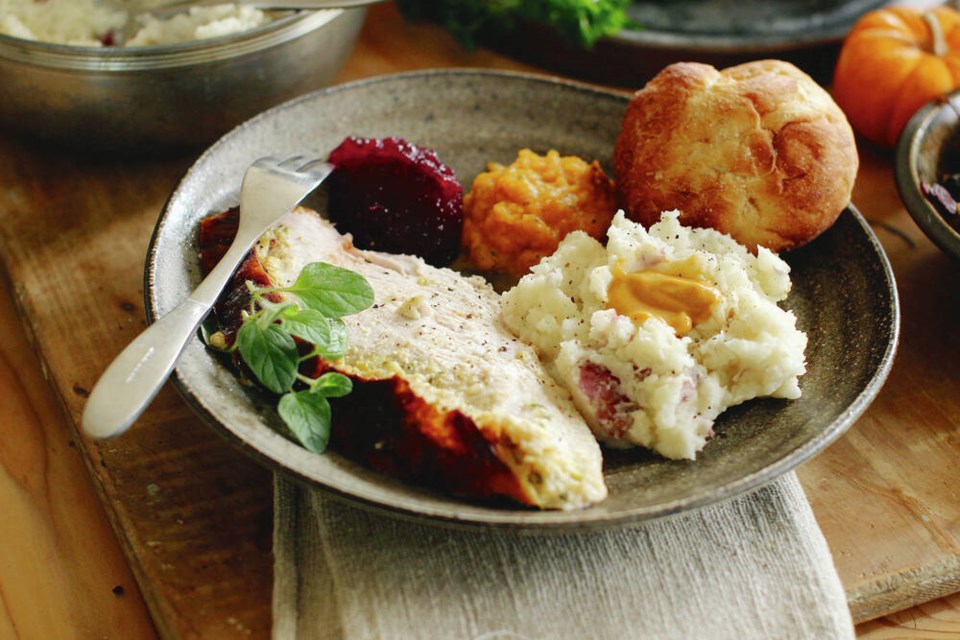One of the things I love about British Columbia is that everybody is from somewhere else, whether via the Beringia continental land bridge thousands of years ago, or the YVR arrivals terminal on Tuesday morning.
Last year, B.C. received the second-highest number of immigrants to Canada: 66,268 people (Ontario came first with 199,297 and Nunavut came last at 45).
These newcomers have to deal with a lot: the language barrier, finding affordable housing, finding employment, adapting to the cold, and understanding our undoubtedly bizarre holiday traditions.
Which brings me to Davesplaining this weekend’s holiday.
Thanksgiving is celebrated on the second Monday in October, after the fall harvest.
It is sometimes called “Canadian Thanksgiving” to distinguish it from the American holiday of the same name, which is held near the end of November, when travel is more icy and dangerous, so as to reduce gun violence.
Thanksgiving has been an official Canadian holiday since 1879 and is celebrated in every province including Quebec, where it is called Jour de l’Action de grâce, which in French roughly translates to “Thanksgiving.”
According to some historians, the first celebration of Thanksgiving in North America happened in 1579 after the safe landing of Martin Frobisher’s fleet in Newfoundland. I should probably mention that, while there were Inuit people about, the Pilgrims and Native American Indians from the Pocahantas cartoon were not.
Frobisher was an English privateer searching for the Northwest Passage, which did not exist because climate change had not yet melted the poles. He tried and failed three times in all, so was pretty tired and hungry. As you probably know, there’s nothing like turkey leftovers to pick a guy up.
Other historians, most notably the ones who consult on Disney movies, stick to the Pilgrim version of North America’s first Thanksgiving in 1623.
This is the version with the Puritans wearing sombre black clothing and silver buckles on their shoes, which take animators less time to draw, and the Wampanoag people being generous with their turkeys and, unfortunately as it turned out for them, their entire future.
If you’re a newcomer to Canada — say you are fleeing next month’s American apocalypse — the food we traditionally serve at the Thanksgiving meal begins with a delicious roast turkey filled with stuffing, which is mostly wet bread, salt and other seasonings, such as more salt.
The specific recipe is often a carefully guarded family secret, and sometimes includes raisins or walnuts. If you are unlucky enough to be with one of those families, call the police immediately.
Along with the turkey comes a belly-expanding parade of mashed potatoes with gravy, cranberry sauce, various autumn vegetables and Brussels sprouts, which no one eats by tradition, and also because of the taste.
Given the customary amount of food on offer, you should wear sweat pants and shoes with no laces.
The Thanksgiving meal traditionally ends with some kind of pumpkin dessert, like apple pie only instead of delicious apple pie, you get pumpkin pie.
I should probably mention that not liking the taste of pumpkin is illegal in British Columbia, where we produce over 10.5 million kilograms of pumpkins and squash every year.
This is also about how much weight we will vow to lose after eating the traditional Thanksgiving meal.
Sharp-eyed readers will have noticed I did not provide a Thanksgiving vegan alternative to roast turkey, gravy, etc. This is only because, technically speaking, the gist of “Thanksgiving” is “giving thanks,” which just doesn’t spring to mind over a plate of seaweed and chia seeds.
Which brings me to the longstanding Thanksgiving tradition of telling everyone at the table what you are most thankful for.
As per last year, Auntie Carol is going to suggest that we all share, instead of passing the glazed carrots, currently cooling at her elbow.
She will start things off, thankful for her “dear cats, especially Mr. Wigglesworth, a champion mouser and dead-ringer for the Mayor of Victoria,” and then start crying because Carol got into the Gewurztraminer early, also as per last year.
The thankfulness sharing tradition often catches me by surprise and requires some quick thinking, not because I don’t have a lot to be thankful for, but because I am usually so far down the line that the good stuff — family, health, avoiding jail time after that little incident at Costco — is already taken.
If this ever happens to you, here are a few emergency thankfulness items you can pull out of your back pocket to share:
• The gravity on our planet is just right to keep things down but not squished down.
• Maple syrup tastes great on pancakes no matter how old you get.
• Not having monkeypox yet.
• What a thorough job the electric toothbrush does every morning.
• Netflix.
Another important Thanksgiving tradition involves a sport called Canadian football, which is not real football but does allow washed-up American football players to keep destroying their knees for a few more years.
Anyway, the Canadian Football League usually holds a nationally televised doubleheader this weekend, the Thanksgiving Day Classic.
Some Canadians take the CFL very seriously. If asked who you think will win the big game, I suggest you play it safe and lean in to the language barrier. Just smile and say “Wayne Gretzky.”
This is hilarious because Wayne Gretzky is actually a famous Canadian ice hockey player.
Like everybody else you meet at Thanksgiving this year, Wayne Gretzky’s ancestors came to Canada from somewhere else. It worked out pretty well for that immigrant family.
We still call him The Great One.



